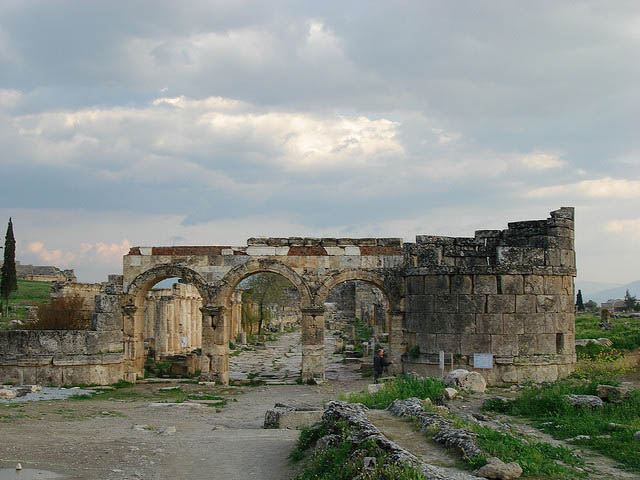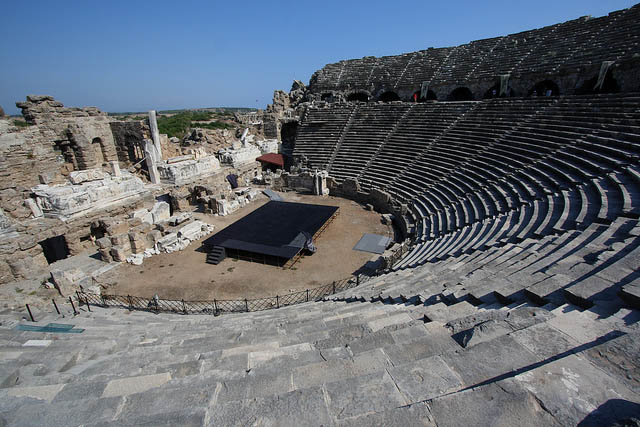Deriving from springs in a cliff almost 200 m high overlooking the plain, calcite-laden waters have created at Pamukkale (Cotton Palace) an unreal landscape, made up of mineral forests, petrified waterfalls and a series of terraced basins. At the end of the 2nd century B.C. the dynasty of the Attalids, the kings of Pergamon, established the thermal spa of Hierapolis. The ruins of the baths, temples and other Greek monuments can be seen at the site.
 |
| Hierapolis Ancient City Turkey |
This site is exceptional by vurtue of its superlative natural phenomena - warm, heavily mineralized water flowing from springs creating pools and terraces which are visually stunning. It is on this outstanding natural site that Hierapolis, an exceptional example of a Graeco-Roman thermal installation, was established. The Christian monuments of Hierapolis constitute an outstanding example of an early Christian architectural complex.
 |
| Cotton Castle , Pamukkale Denizli Turkey |
Pamukkale, which literally means 'cotton castle', is the name the Turks gave to the extraordinary site of Hierapolis. The name was inspired by the preternatural landscape of bizarre forms created by calcite deposits from the hot springs that surface through a fault: mineral forests, petrified cascades and terraced pools of an immense natural nymphaeum. The ancients attributing healing powers to the hot springs (35 °C) equal to their power to metamorphose the landscape, they founded a thermal station on the site in the late 2nd century. The history of Hierapolis followed the same course as many Hellenistic cities in Asia Minor. The Romans acquired full control of it in 129 BC and it prospered under its new rulers. It was a cosmopolitan city where Anatolians, Graeco-Macedonians, Romans and Jews intermingled. The hot springs which attracted throngs of people 'taking the waters' also served another purpose: scouring and dying wool.
The therapeutic virtues of the waters were exploited at the various thermal installations which included immense hot basins and pools for swimming. Hydrotherapy was accompanied by religious practices, which were developed in relation to local cults. The Temple of Apollo was erected on a fault from which noxious vapours escaped. The theatre, which dates from the time of Severus, is decorated with an admirable frieze depicting a ritual procession and a sacrifice to the Ephesian Artemis. The necropolis affords a vast panorama of the funerary practices of the Graeco-Roman epoch. According to ancient tradition, Philip the Apostle converted it and was crucified there by Domitian around the year 87. Hieropolis remained one of the two metropolises of the Phrygia Pacatiana as well as being a bishopric. The group of Christian buildings are the cathedral, baptistry and churches. The most important monument is the martyrium of St Philip. At the top of a monumental stairway, the octagonal layout of the building is remarkable because of its ingenious spatial organization. The fortress, built on the cliff, testifies to its ultimate historic phase.
The Pamukkale National Park is the focal point for the natural values of the site, formed by its highest travertine terraces, with 20 m high cliffs and waterfalls, and situated along on the foothills of the Cokelez Mountains. The terrace is about 200 m above the Curuksu plain and extends some 6 km between the villages of Pamukkale and Karahayit. Semi-circular pools occur in a step-like arrangement down the upper third of the slope. Fresh deposits of calcium carbonate give the pools a dazzling white coating. The travertine deposits, Quaternary in age, are thought to originate from a fault in the contact zone between the Mesozoic crystalline rocks and the layers of the Neogen series. The springs form part of a complex hydraulic system extending 70 km to the north-west to Alasehir and west along the valley of the Menderes River. These canals take thermal water to nearby villages and agricultural areas, some over the years having accumulated travertine deposits up to 10 m in height. The oldest rocks in the area are crystalline marbles, quartzite and schists and are located in the northern parts of the park. Most of the rocks are of the Pliocene epoch.
A vegetation map produced in 1969 showed land use, in descending order of area covered, as cultivated land, bare land subject to erosion, bare land urban areas and maquis. There are some 45 species of flowering plant, while in Denizli Province there are records of ten species of mammal and ten species of bird. State ownership around 500 m, rising to 1,840 m in the Cokelez mountains, to the immediate north of the park peaks further out but surrounding the park rise to 2,308 m (Babadağ) and 2,571 m (Honaz).
The natural features of the site provide the setting that attracted the original Roman town of Hierapolis. They thus form an important backdrop for the cultural landscape that now dominates the area.
 |
| Amphitheatre - Hierapolis Ancient City , Turkey |
(Text Content Source:- Wikipedia. Images Source:- Wikimedia, Google, Picasa, Bing, Yahoo, Flickr & etc….)
(Images are copyrighted by their owners. All are free images, taken from the web with the consent of owners who they approved to download it, and any copyright issues found by any image owners, contact the administrator immediately.)



































Say something! Leave a Reply ?